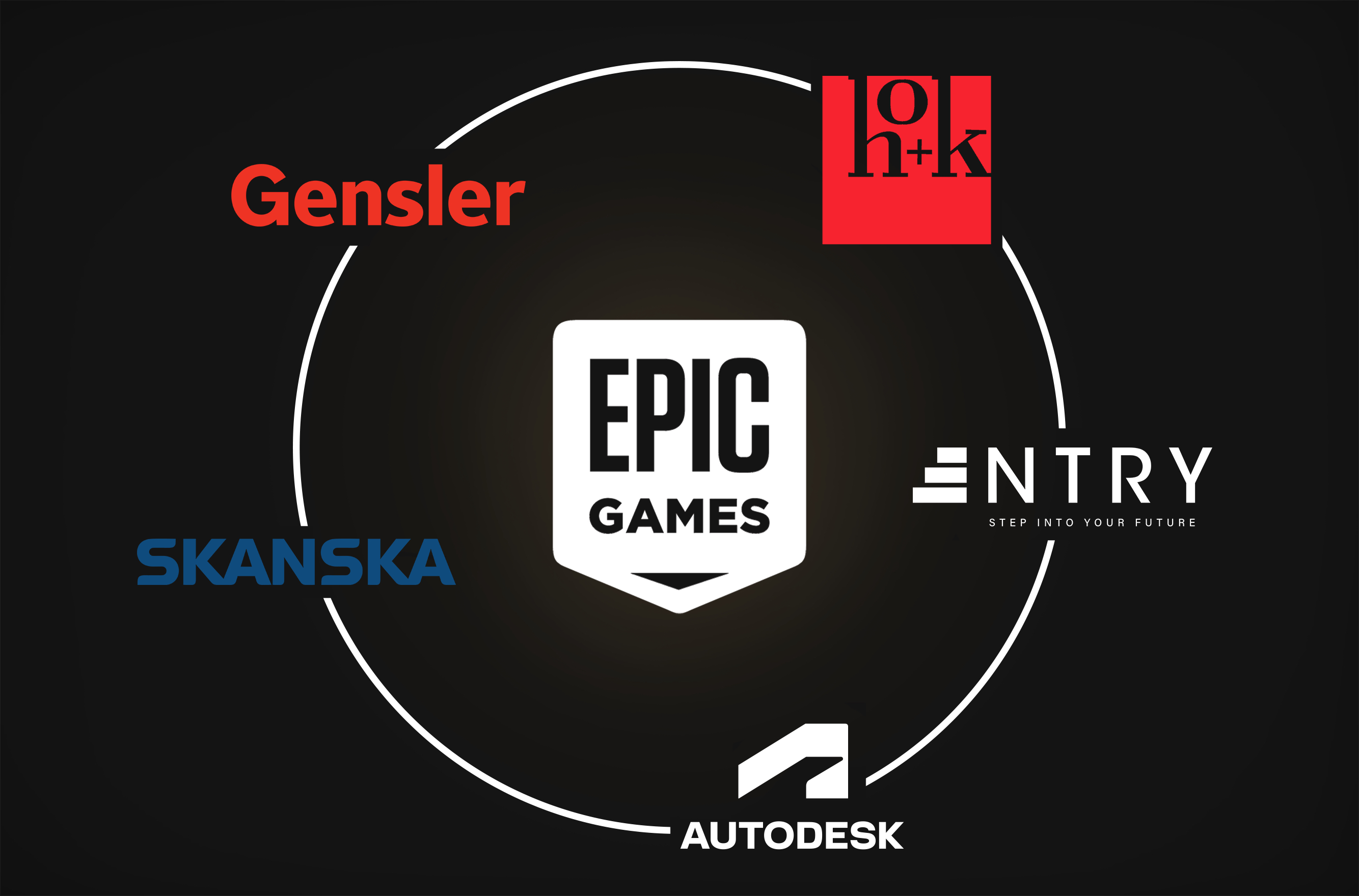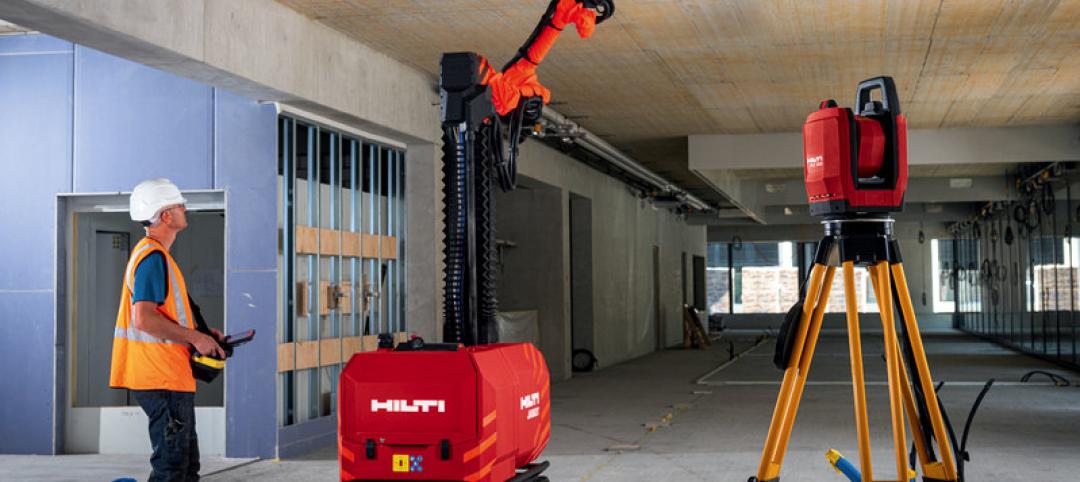Autodesk has announced its collaboration with Epic Games (yes, the people behind Fortnite) to accelerate immersive virtual modeling in the Architecture, Engineering, and Construction (AEC) industry.
What does designing and building homes have to do with video games? Well, Epic Games develops one of the most powerful real-time 3D design tools out there today: Unreal Engine. The latest iteration of the free tool, Unreal Engine 5, utilizes technical achievements to simulate hyper-realistic environments in real-time.
Unreal has already been used across many other industries: film and television, architecture, and even the automotive industry. It seems, though, that more and more AEC firms are beginning to dip their toes into the world of Unreal Engine’s computer-aided design.
AEC INDUSTRY FIRMS USING UNREAL ENGINE
HOK
Architecture firm, HOK, is one company utilizing Epic Games’ technology. Through the power of Unreal Engine alongside Epic Games’ other design tool, Twinmotion (more on that later), HOK is creating virtual reality (VR) walkthroughs to aid in a Canadian architectural renovation project.
These “brick-to-beam” interactive walkthroughs are meant to serve as a preview of what Canada’s iconic Centre Block will look like for years to come. HOK finds that using computer-aided design for this project is beneficial, as clients can clearly see what they like and don’t like about the model—all before spending billions of dollars on the project.
Skanska
Skanska Sweden used Unreal Engine with 3ds Max during the development of a 700,000 square-foot research facility in 2019. The firm leveraged the 3D modeling tools to create VR renderings of the project, as well as high-quality visualizations with realistic lighting scenarios.
“Using 3D tracking with a drone enabled us to visualize the 3D-modeled designs in actual surroundings, many years prior to completion,” says Ronald Cruz, BIM coordinator, Sweco Architects. “Rendered contents from 3ds Max proved beneficial regarding the communications between design, contractors, stakeholders, and the board of directors.”
VIRTUAL REAL ESTATE WITH UNREAL ENGINE 5
NTRY
NTRY, a Canadian cloud-based real estate company, has developed a digital tool for buyers to tour properties in the real estate market. Touting itself as the first real estate metaverse, NTRY utilizes the power of 3D CityScapes—powered by Unreal Engine—which specializes in creating digital interactive environments.
NTRY’s web-based tool—aimed mostly at brokers, agents, developers, and buyers—grants users the ability to access online virtual showings from anywhere in the world. Realtors are able to show clients multiple on-the-market homes from the comfort of their office.
This allows prospective buyers to “experience the heights of a downtown condo, the quietude of the suburbs, or walk through the bustling city streets,” according to NTRY. The tool includes the ability to change finishes and design choices in real-time, like swapping out a marble countertop for granite, for example.
V2i Realtime
Another beneficial use of Unreal Engine is being able to properly showcase the size and scale of projects. V2i Realtime is another company doing such things, consolidating all of a project’s data into a single 3D environment.
What this means, then, is that stakeholders and clients are able to explore the digital space from any device with a web browser. This is done through Pixel Streaming, in which visual “noise” (that can lead to misinterpretation, errors, and confusion) is reduced.
“Unreal Engine eliminates so much wasted time, energy, and dollars that we often see as a result of the need for third-party interpretation of traditional, and often technical, 2D data and reports,” says Luke Brannelly, founder, managing director, and creative director at V2i Realtime.
EPIC GAMES’ TWINMOTION TOOL
Autodesk
Epic Games has more tools than Unreal, too. In its recent partnership with Autodesk, Epic Games is giving those with Revit subscriptions the ability to access Epic’s other tool, Twinmotion, for free.
The two companies believe this integration between Autodesk Revit and Twinmotion will allow users to spend more time bringing their design ideas to life, and “less time handling complex data and technical workflows,” according to Marc Petit, vice president, Unreal Engine Ecosystem at Epic Games.
But what makes Twinmotion different from Unreal Engine?
Twinmotion
While Unreal marries real-time design with user interactivity, Twinmotion largely focuses on creating visualizations to be exported as images or 360 degree video. Though Twinmotion is powered by Unreal Engine, it’s built to be used more frequently by architects, urban planners, landscaping professionals, and even consumer product designers.
Epic Games touts Twinmotion’s “one-click sync” capability—being able to easily import designs from Revit, SketchUp Pro, Archicad, BricsCAD, Rhino, Vectorworks, and more.
With the new Autodesk partnership, Revit subscribers can now launch Twinmotion directly from the Revit ribbon.
WHAT IS THE BENEFIT OF COMPUTER-AIDED DESIGN?
There are dozens of other AEC and real estate firms not listed here that utilize Epic Games’ technology for their businesses. From Gensler to Foster+Partners, it seems more and more companies are adding tools like Unreal Engine to their design arsenal.
However, there’s a reason not every company is quickly jumping into the world of Unreal. Though Epic’s tools are designed to be intuitive, it still takes time and practice to transition workflows from software to software. Most firms may not have the financial resources to train people on Twinmotion/Unreal Engine. Plus, real-time high-quality virtualization doesn’t come cheap, as a decently high-powered computer needs to be used to get the full benefits of the software.
But when it is used, computer-aided design can prove to be a powerful visualization tool that aids in communication, clarity, and productivity.
Related Stories
AEC Tech | Dec 21, 2020
GIS benefits are widely accepted, but measurements of importance vary among AEC firms
Future usage might boil down to competitive pressure, according to a Dodge Data & Analytics survey.
AEC Tech | Dec 17, 2020
The Weekly show: The future of eSports facilities, meet the National Institute for AI in Construction
The December 17 episode of BD+C's The Weekly is available for viewing on demand.
AEC Tech | Dec 15, 2020
DLR Group launches intelligent air quality analytics platform
sonrai IAQ™ by DLR Group delivers actionable intelligence to optimize facility operations and enhance occupant comfort.
AEC Tech | Dec 8, 2020
COVID-19 affects the industry’s adoption of ConTech in different ways
A new JLL report assesses which tech options got a pandemic “boost.”
Contractors | Dec 4, 2020
‘Speed to market’ defines general contractor activities in 2020
Contractors are more receptive than ever to ways that help get projects done faster.
Smart Buildings | Nov 20, 2020
The Weekly show: SPIRE smart building rating system, and pickleball court design tips
The November 19 episode of BD+C's The Weekly is available for viewing on demand.
AEC Tech | Nov 12, 2020
The Weekly show: Nvidia's Omniverse, AI for construction scheduling, COVID-19 signage
BD+C editors speak with experts from ALICE Technologies, Build Group, Hastings Architecture, Nvidia, and Woods Bagot on the November 12 episode of "The Weekly." The episode is available for viewing on demand.
AEC Tech | Oct 28, 2020
Meet Jaibot, Hilti's new construction robot
The semi-autonomous robot is designed to assist MEP contractors with ceiling-drilling applications.
Smart Buildings | Oct 26, 2020
World’s first smart building assessment and rating program released
The SPIRE Smart Building Program will help building owners and operators make better investment decisions, improve tenant satisfaction, and increase asset value.
AEC Tech | Oct 23, 2020
Risk mitigation: Seeing the forest and the tree
This case study highlights how new data analysis tools can be successfully leveraged to gain insights into some of the more abstract aspects of building evaluations.
















